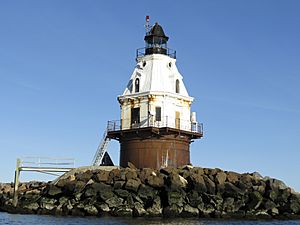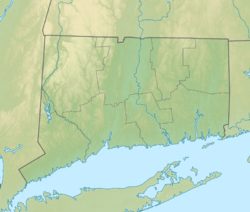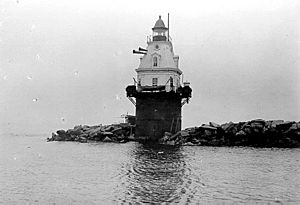Southwest Ledge Light facts for kids
 |
|
| Southwest Ledge Light | |
|
|
|
| Location | New Haven Connecticut United States |
|---|---|
| Coordinates | 41°14′04.08″N 72°54′43.55″W / 41.2344667°N 72.9120972°W |
| Year first constructed | 1877 |
| Automated | 1973 |
| Foundation | cast iron and concrete caisson basement |
| Construction | cast iron tower |
| Tower shape | octagonal tower with balcony and lantern incorporating 2-storey keeper's quarter |
| Markings / pattern | white tower, black lantern, brown basement |
| Height | 45 ft (14 m) |
| Focal height | 57 ft (17 m) |
| Original lens | Fourth order Fresnel lens |
| Current lens | VRB-25 |
| Range | 14 nautical miles (26 km; 16 mi) |
| Characteristic | Fl R 5s. |
| Fog signal | 1 blast every 15s |
| Admiralty number | J0780 |
| ARLHS number | USA-778 |
| USCG number | 1-21210 |
The Southwest Ledge Light is a working lighthouse that helps guide ships into New Haven Harbor in New Haven, Connecticut. It was finished in 1877. This lighthouse was special because it was one of the first to use a strong, round iron base. This new design, created by Maj. George H. Elliot, helped the lighthouse stand firm against moving ice. It was a big step forward in how lighthouses were built! In 1990, the lighthouse was added to the National Register of Historic Places, which means it's an important historical site.
Contents
About the Lighthouse Design
The Southwest Ledge Light stands at the end of a long stone wall called a breakwater. This breakwater is on the eastern side of the main path into New Haven Harbor. The lighthouse was first built to warn ships about an underwater rock area.
The lighthouse itself is a three-story building. It sits on a round iron base that is set into concrete. Large rocks, called riprap, surround the base to protect it. The building has eight sides, making it octagonal.
Cool Features of the Lighthouse
Around the main level of the lighthouse, there's an open balcony with a railing. Big metal supports hold up this balcony. The top of the building has a special type of roof called a mansard roof. Above this roof is where the lantern house sits.
The lantern house also has a railing around it and a bell-shaped roof. The lighthouse looks very fancy, with a style called Second Empire. You can see this in the decorative window frames and the rounded windows in the roof. Most of these parts are made of strong cast iron, while the rooms inside are framed with wood.
History of the Lighthouse
Building the Southwest Ledge Lighthouse started in 1873 and was completed in 1877. An interesting fact is that the top part of the lighthouse, called the superstructure, was first shown off at a big event called the Centennial Exposition in Philadelphia in 1876.
To finish the lighthouse faster, a copy of that superstructure was built and put in place at Southwest Ledge. The original one from the exposition was later used for another lighthouse called the Ship John Shoal Light in Delaware Bay.
Changes Over the Years
In 1911, the base of the lighthouse was made even stronger. Later, in the 1930s, cranes were added to help boats get closer, though only their foundations remain today.
The lighthouse became automated in 1973. This means it no longer needed people living there to operate it. It still works today, helping ships find their way. In 2016, the lighthouse was put up for sale and was bought by Dr. Casey Jordan.




